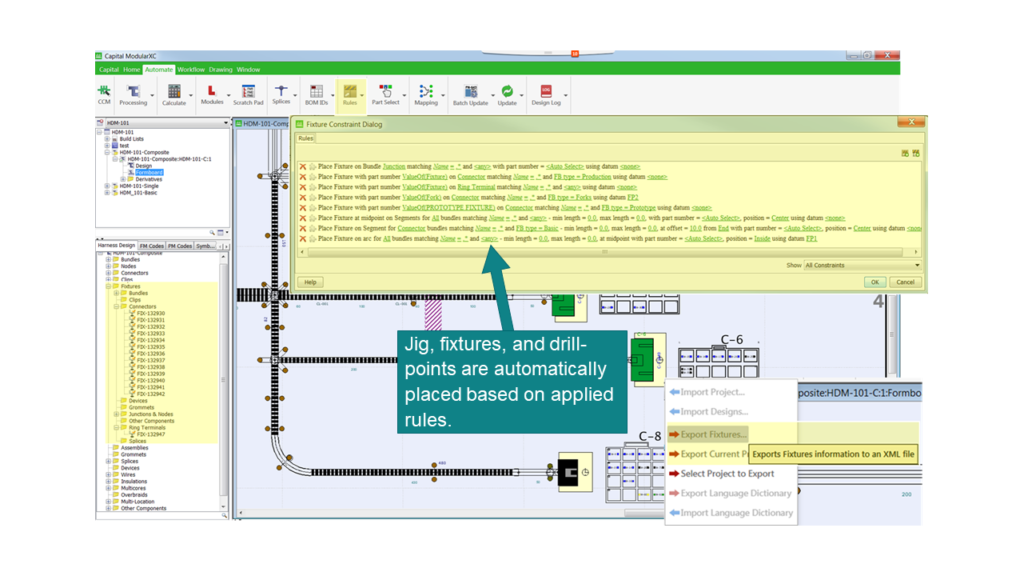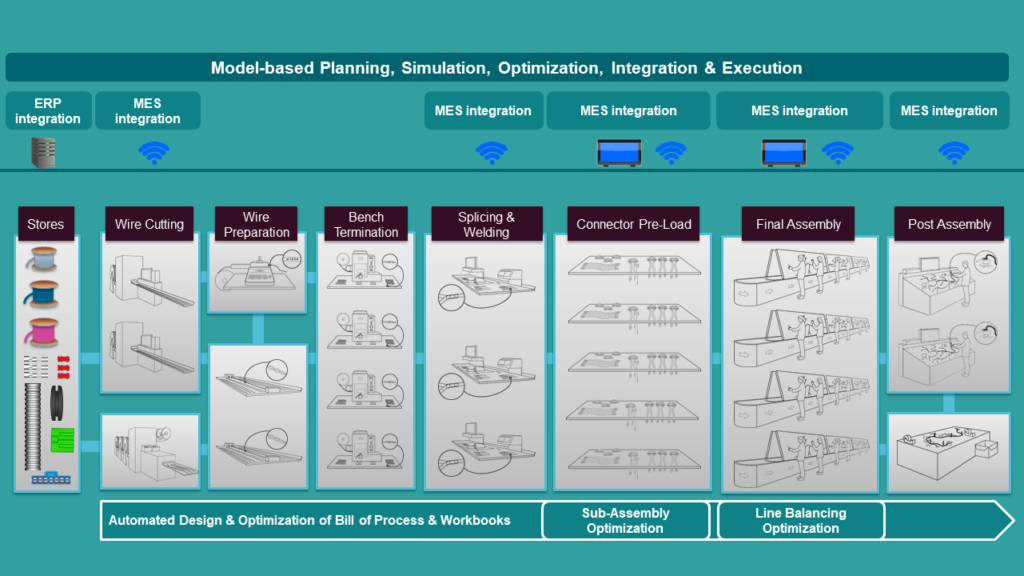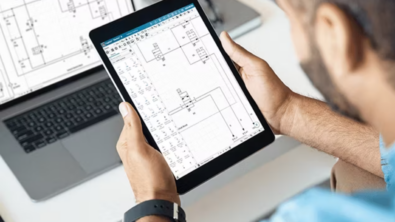Bringing wire harness manufacturing into the digital age

The increase in electrical and electronic features in modern vehicles is placing more emphasis on the wiring harness that transmits power and signals between actuators, sensors and ECUs (figure 1). The continued development of advanced driver assistance systems (ADAS) and electric powertrains has been particularly impactful, as they require additional sensor hardware and specialty wiring to transmit data and power. Furthermore, increasing demand for driver assistance systems and electrically propelled cars is driving growth in the wire harness manufacturing industry. Analysts predict that by 2023 the automotive wiring harness industry will grow to over 70 billion dollars in yearly revenue and more than 91 billion dollars by 2025 (Future Market Insights, 2016).

In the previous blog, we looked at the challenges these trends are causing for wire harness manufacturing companies. Namely, growing wire harness and vehicle variant complexity are straining the traditional methods of wire harness manufacturing engineering. As these companies began to grasp these challenges, they will need to adopt a digitalized model-based systems engineering (MBSE) flow to manage complexity and ensure accuracy while manufacturing wire harnesses for tomorrow’s complex vehicles. Part 2 will continue this discussion and demonstrate the benefits of digitalization and MBSE for wire harness manufacturers.
Leveraging Digitalization in Wire Harness Manufacturing
Wire harness manufacturers are concerned with designing sub-assemblies, engineering formboards, line balancing, and generating the bill of process and workbooks. Manufacturers also operate within the context of a larger ecosystem. They typically must interact with an enterprise resource planning (ERP) system, manufacturing execution systems (MES), as well as systems on the shop floor that need to be connected, such as wire preparation and automatic test equipment.
Digitalization can streamline the passing of data from each of these systems and processes to each of the others. Automation further improves the effectiveness of harness manufacturing enterprises. Engineers specify design rules to guide the automation, embedding their experience and best practices into the process. Then, the automation leverages the product and process digital models to complete a variety of tasks including generating process designs, calculating costs, and producing documentation for assemblers on the shop floor. The digital twin provides the model, and the automation generates the information needed downstream.
For example, design rules can automate formboard fixture selection, placement, and other factors (figure 2). Senior engineers with years of experience selecting and placing these fixtures can describe guidelines for the best fixture type, placement, and quantity given the junction, connector, and bundle size and length. With a digital twin of the harness, advanced wire harness engineering software, such as Capital, can apply these rules to automate the placement of fixtures, drill points, and jigs, greatly accelerating formboard design speed and accuracy.

Furthermore, upstream project delays can reduce the time available for the manufacturing engineers to generate work instructions. If the instructions arrive late or with inadequate detail, then the assemblers on the shop floor must seek out additional guidance. Furthermore, inadequate instructions can degrade the quality of the finished harnesses, causing them to fail post-production testing. Suddenly, key program delivery milestones are missed, and unexpected late freight costs are incurred to make up for lost time and yield.
With an enriched digital model of the harness and production process, engineers can automatically generate work instructions. Engineers can incorporate workbook templates, libraries, and style sets to ensure the instructions are accurate and comply with company industrialization and quality standards. The generated work instructions also include diagrams for twisted wires, jacketed multi-cores, spliced daisy chains, and more. Using a digital thread to make this a continuous process, fed from the same data from start to finish, can greatly improve the efficiency and accuracy of the final assembly process.
In the future, digitalization and the digital thread will enable companies to accomplish much more. A traditional shop floor begins with preparing materials for assembly through wire cutting, wire preparation, splicing, and connector pre-load. Then, the harness is assembled on the formboards, and technicians perform post-assembly tasks. Advanced wire harness solutions can automate much of these processes. Moving forward, these solutions will integrate with a network of other manufacturing systems (figure 3).

ERP systems will help manage the material stores for harness manufacturing, while a manufacturing execution system (MES) can supply workbooks around the shop floor, gather and supply real-time data from the shop floor, and generate feedback based on that data to help improve the processes and designs. With an entirely digitalized process, from model-based planning and simulation to integrated manufacturing systems, harness manufacturers can realize significant improvements in efficiency and productivity.
Preparing for the Wire Harness Industry of Tomorrow
The fabric of the harness manufacturing industry is changing as new automotive technologies accelerate the already growing harness complexity across the industry. The increasing electrical and electronic content of today’s vehicles shifts the responsibility for critical vehicle functions to the wiring harness. This shift from mechanical to electronic enablement, coupled with more and more sophisticated electronic systems, means that harnesses are more complex than ever. Demands for speedy and efficient production of harnesses are also ramping up as automotive companies vie to beat their competition to market.
In order to survive and grow in this challenging environment, harness manufacturers must significantly change their methods. Digitalization is a key adaptation for harness makers, offering the tools needed to survive in an extremely dynamic industry. A digital model-based flow unifies the previously fragmented domains of design and manufacturing and captures tribal knowledge held by experienced engineers through integrated design rules. To meet the demands of an evolving industry, it is time for wire harness manufacturers to become digital enterprises.
Read more in our whitepaper: Model-based wire harness manufacturing


